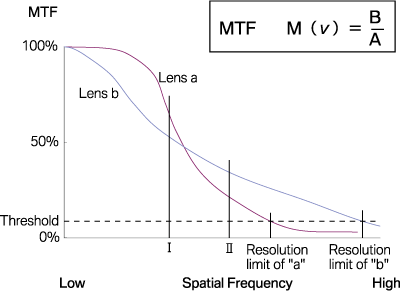MTF and Resolution
In general, the quality of a lens is often judged by its resolution value, but in fact, both MTF and resolution are highly relevant. The figure below illustrates the relationship between resolution and MTF.
The figure shows the MTF curves for two lenses with different performance. Lens (a ) has a low critical resolution but high contrast performance at low spatial frequency, while lens (b ) has a high critical resolution and low contrast performance at low spatial frequency.
As mentioned above, since contrast is normally reproduced faithfully at low frequencies, the MTF is close to 100% and contrast at high frequencies becomes indistinct, and therefore the image becomes gray and indistinguishable beyond the limiting resolution frequency.
In reality, aberration in the lens causes the contrast to be lost before the critical resolution is reached. Generally speaking, the threshold is 0.1.
If you look at Figure 4 with this in mind, you can see the following.
When verifying in the low frequency region around I described in the MTF graph, lens a is better, and when verifying in the high frequency region around II, lens b is better.
From the above, it seems that lens b, which has a good basic performance (limit resolution), is the better lens, but in the end it depends on the usage environment of the person who uses it, and is difficult to judge the quality of the lens based on resolution alone.
【Video】Resolving power and MTF

